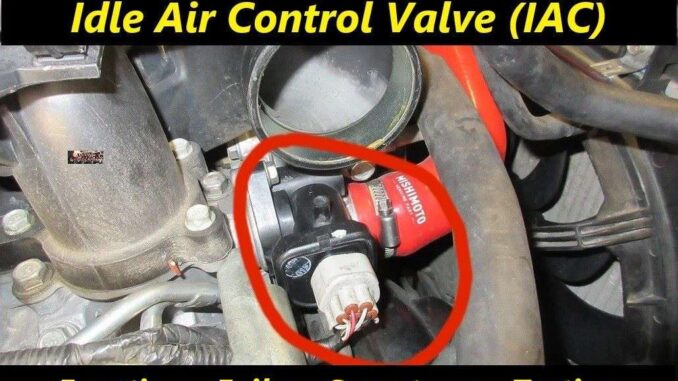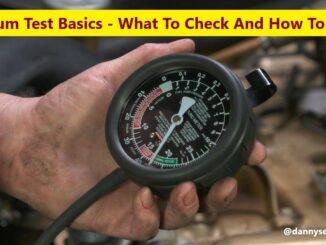
SO, THE IDLE AIR CONTROL VALVE, IS RESPONSIBLE FOR MANAGING THE ENGINES IDLE SPEED.
And, that’s what makes the idle air control valve, a major management component of the engine. Because, it decreases or increases the (RPM) of the engine, depending on what the current operating conditions call for.
FUNCTION
The valve is usually connected to the throttle body, next to the intake manifold. But, it is the engine control unit (ECU), that manages all the functions of the (IAC).
Based on the information it receives, like engine load and temperature, it will change the speed of the idle accordingly. So, if a engine idles erratically and surges, that could be the sign of a failing valve.
COMMON FAILURE SYMPTOMS OF A BAD VALVE
So, when the valve fails, it can cause all sorts of issues. And, in some cases, may even render it undrivable. Usually, a bad or failing valve, will produce a few failure symptoms.
Related Engine Code P0505
If the code P0505 appeared soon after the battery has been replaced or disconnected. Then, it’s a good idea to try performing the idle relearn procedure. The procedure varies for different cars.
Irregular Idle Speed
So, one of the most common symptoms associated with a problematic valve is, irregular idle speed. The valve is programmed, to regulate and maintain the engine idle speed, at a constant rate. So, if the valve fails or has any issues, it can cause the idle speed to be thrown off. This may result in an unusually high or low idle speed. And, in some cases, a surging idle speed, that repeatedly climbs and falls.
Check Engine Light (CEL) Coming On
Another symptom of a potential issue with the valve, is a (CEL) coming on. As a result, of the (ECM) detecting an issue with the valve circuit or signal. But, the (CEL), can also come on for a variety of other issues. Therefore, having the computer scanned for trouble codes, is highly recommended.
Rough Engine Idle
A normal healthy valve, will provide smooth idling in your car. But, if the valve goes bad for any reason, the idling will go from, smooth to rough. A rough idle will result in, intense vibrations forming, whenever your car is stopped with the engine running. Since less air will be going into the engine during its idle state, the car will react by shaking profusely.
Engine Stalling
Another more serious symptom of an issue with the valve is engine stalling. If the valve fails completely, it may leave the engine, without a source of air. This may result in the engine stalling while operating. And, in some cases, may result in an engine that will not idle at all.
Stalling Under Load
Sometimes the engine stalling will happen on its own. While other times, increasing the load on the engine, will cause it to stall. For example, if you turn on your heater or air conditioner, then your engine will probably stall immediately afterward. And, the steering wheel might also feel, like it’s being dragged to one side too.
HOW TO CLEAN THE IDLE AIR CONTROL VALVE
One common problem is a buildup of carbon or fuel varnish deposits, in the valve. The cure for this condition is to clean the valve, with some aerosol throttle cleaner or engine top cleaner.
Follow These Common Instructions:
- Disconnect the air intake ductwork, from the throttle body.
- Start the engine, then increase and hold the idle speed to 1,000 to 1,500 (RPM).
- Spray the throttle cleaner or engine cleaner into the throat of the throttle body. But, try aiming for, the idle air bypass port.
- Turn the engine off, to allow the cleaner to soak into the valve passageway.
- Wait about three minutes.
Restart the engine, rev and hold at 1,000 to 1,500 (RPM), and repeat the cleaning process again.
- Turn the engine off again, and reattach the air intake duct work to the throttle body.
Start the engine and rev and hold to 1,500 to 2,000 (RPM). Consequently, until no white smoke, is coming out of the exhaust pipe.
- If the idle speed still surges after this, the valve is defective and needs to be replaced.
HOW TO DO BASIC TESTING OF THE VALVE
In the event of an electrical fault, a spring maintains the rotary valve in a fixed position. As a result, the idling speed is increased to approximately 1200 (RPM). The (ECM) incorporates a self-learning system, which enables it to learn the ideal idling speed. Because of this feature, the valve is not adjustable.
First, Disconnect the negative battery cable, and unplug the valve connector.
How To Test, The Coil Driver Circuits In The Idle Air Control Valve:
- Using a Digital Multimeter, measure the resistance between pins 3 and 2 on the valve.
- Resistance should be 10-14 ohms.
- If resistance is ok, proceed to the next step.
- However, if resistance is out of range, replace the valve and retest.
Finally, do the same thing with, pins 1 and 2 on the valve.
Next, How To Test, The Voltage Lead:
- Using a Digital Multimeter, measure the voltage at terminal 2.
- Turn the ignition ON , and measure the voltage between terminal 2 and ground.
- Voltage should be battery voltage.
- If voltage is not present or out of range, repair the circuit.
- If voltage is ok, proceed to the next step.
How To Test, The Signal Return:
- Using a Digital Multimeter, measure the voltage at terminal 1.
- Turn the ignition ON , and measure the voltage between terminal 1 and ground.
- Voltage should be around 6.0-8.5v.
- If voltage is not present or out of range, repair the circuit.
- If voltage is ok, proceed to the next step.
How To Test, The Ground Circuit:
- Using a Digital Multimeter, measure the resistance at terminal 3.
- Turn the ignition ON , and measure the resistance between terminal 1 and ground.
- Resistance should be 0 ohms.
- But, if continuity is not present or out of range, repair the circuit.
- Finally, if continuity is ok, replace the (CMP) sensor and retest.
CONCLUSION
So, if your car is experiencing any of the symptoms above, do the troubleshooting first. Finally, if the idle air control valve fails, just replace it.
BY DANNY BENDER




